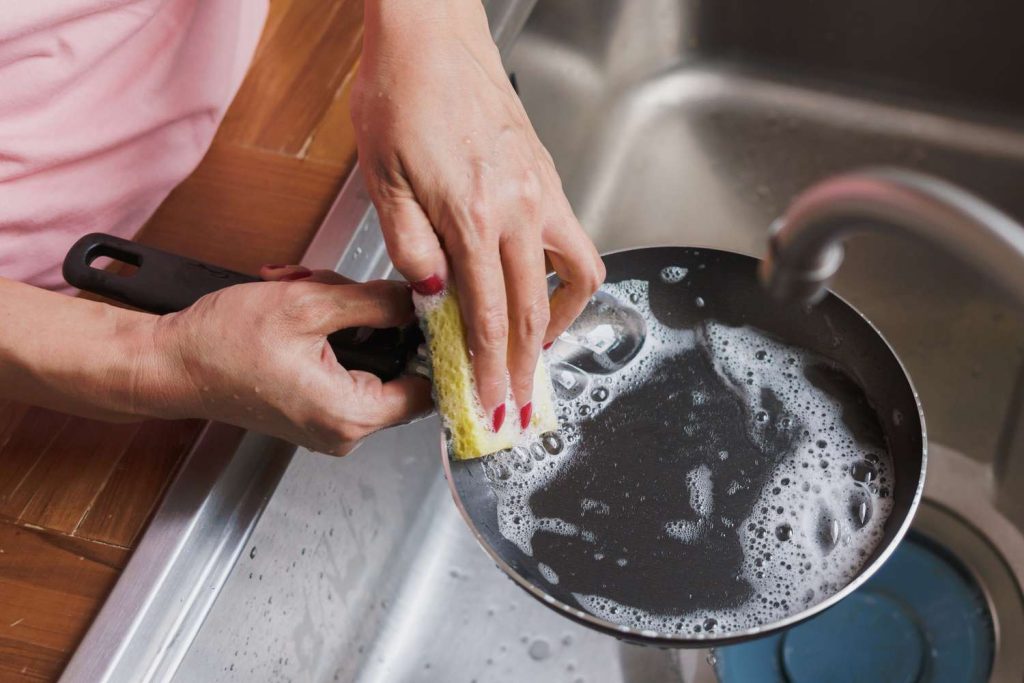:max_bytes(150000):strip_icc():format(jpeg)/GettyImages-2143221056-d1d3f5cd73cf46179186463df6a52a1e.jpg)
Your kitchen might not be the first place that comes to mind when you think about potential health hazards. However, many everyday kitchen items you rely on could expose you to harmful chemicals, such as bisphenol-A (BPA) in plastics, “forever chemicals” in nonstick cookware, or flame retardants in black plastics.
Heat, friction, and wear, such as stirring food, grinding spices, or brewing coffee, can cause harmful chemicals to leach (seep) into food and drinks. However, the associated health risks depend on how much exposure you have to these items and under what conditions.
1. Nonstick Cookware
One of the biggest concerns about nonstick cookware is its potential to release PFAS (per- and poly-fluoroalkyl substances), which are also known as forever chemicals.
When nonstick coatings (typically polytetrafluoroethylene or Teflon) are heated above 500 degrees F, they can degrade and emit toxic fumes that may cause polymer fume fever—a temporary flu-like illness in humans.
Teflon cookware can also leach microplastics into food, especially when the coating becomes scratched, chipped, or worn down over time.
If you want safer alternatives, opt for ceramic pans with a nonstick coating, stainless steel, or cast iron.
2. Coffee Pods
Plastic and aluminum single-use coffee pods may leach harmful substances into coffee when exposed to hot water and pressure.
Plastic pods introduce risks through hormone-disrupting chemicals called xenoestrogens, which can interfere with natural hormone function and potentially cause reproductive issues like low sperm count. They can also shed microplastics (tiny plastic particles) into brewed coffee, affecting gut health and increasing the risk of chronic systemic (throughout the body) inflammation.
Aluminum-lined pods can leach aluminum into coffee, which can accumulate in the body over time. High aluminum levels are linked to increased risks of breast cancer and neurodegenerative conditions like Alzheimer’s disease and Parkinson’s disease.
Their health impact may be cumulative—while occasional coffee pod use likely poses minimal risk, regular consumption could lead to concerning chemical exposure levels.
Instead of using coffee pods regularly, consider switching to a stainless steel French press or glass pour-over coffee.
3. Plastic Spice Grinders
Plastic spice grinders are often included with store-bought spices like salt, pepper, and herbs. A study examining plastic spice grinders found that grinding mechanisms made from plastic can wear down over time, releasing microplastics into ground spices.
While the long-term health effects are still uncertain, studies suggest microplastics can disrupt the gut microbiome (the habitat of good and bad bacteria and other microbes in the gastrointestinal tract) by altering the balance of beneficial bacteria. Altered gut bacteria could lead to chronic inflammation and weakened immune system function, increasing the risk of chronic conditions like diabetes, cardiovascular disease, and autoimmune disorders.
Choose glass or stainless steel spice grinders instead of plastic ones to avoid microplastic contamination from grinding mechanisms.
4. Food Storage Containers
Some plastic food storage containers—particularly plastics labeled 3, 6, and 7—may leach harmful chemicals or microplastics into your food and pose health risks, especially when exposed to heat. Here’s how:
- Number 3 (PVC/vinyl): Contains phthalates, chemicals that soften plastic but can leach into food and disrupt hormones
- Number 6 (Polystyrene/styrofoam): Contains styrene, a possible carcinogen that can migrate into food when exposed to heat
- Number 7 (Miscellaneous plastics, including BPA): Contains bisphenols (BPA, BPS, BPF), known endocrine disruptors linked to fertility issues, metabolic disorders, and developmental problems in children
To minimize risks, experts recommend choosing glass or stainless steel food storage containers and avoiding microwaving or washing plastic food storage containers in the dishwasher.
5. Cutting Boards
Low-quality wooden boards may contain glues or sealants with formaldehyde or other toxic compounds that can seep into food over time.
Microplastic particles can shed from worn-down plastic cutting boards, potentially contaminating food and contributing to hormone disruption, inflammation, and other long-term health risks. Some plastic boards may also contain BPA, phthalates, or other harmful chemicals that can leach into food, particularly when exposed to heat or acidic ingredients.
Choose glass, bamboo, or sustainably harvested hardwood boards instead of plastic or more porous wood cutting boards.
6. Aluminum Foil
One study found that aluminum from foil can transfer into food, raising health concerns with long-term exposure. While the human body can process small amounts of aluminum, excessive exposure has been linked to neurodegenerative diseases, potential risks for bone disorders, and impaired kidney function.
Aluminum from foil can be transferred into food, raising health concerns over the long term. Certain groups, including children, older adults, and people with kidney disease, may be more vulnerable to aluminum accumulation in the body.
Avoid using aluminum foil for cooking and baking, and switch to parchment paper or glass bakeware for safer, heat-resistant options.
7. Cooking Utensils
The materials used in cooking utensils can affect food safety and long-term health. Many cooking utensils, especially those made from aluminum, copper, and lower-quality metal alloys, can leach toxic metals into food, posing serious health risks.
Research shows that aluminum cookware, especially newer ones, releases heavy metals like lead, nickel, cadmium, and chromium, especially when cooking acidic foods. These types of utensils may increase the risk of neurological issues, kidney damage, and other chronic illnesses.
Replace plastic and black plastic utensils with wooden, stainless steel, or high-quality silicone ones. These materials are free from flame retardants, BPA, and microplastic shedding.
Microplastics: A Growing Health Concern
Microplastics in food and the environment are a growing concern. A recent study estimates that the average person ingests up to 5 grams of microplastics per week—about the weight of a credit card—mainly through food and beverages.
How Much Is Toxic?
The human body can process small amounts of many substances, but repeated exposure, especially in high amounts, can increase the risk of adverse health effects. Factors like heat exposure, wear and tear, and food acidity can influence the amount of contaminants that leach into food and accumulate in the body.
While a single meal cooked in an aluminum pan or one coffee brewed from a plastic coffee pod may not cause immediate harm, long-term, repeated exposure can lead to a build-up in the body. Over time, this can potentially contribute to inflammation and increase the risk of neurological disorders, hormone imbalances, reproductive issues, and cancer.
Summary
Many everyday kitchen items, like black plastic cooking utensils, nonstick cookware, coffee pods, and spice grinders, may expose you to toxic chemicals, heavy metals, and microplastics. These everyday items can leach harmful substances like BPA, phthalates, PFAS, and flame retardants into food, especially when exposed to heat or wear.
Swapping plastic, aluminum, and nonstick materials with safer materials like glass, stainless steel, wood, and silicon can create a healthier kitchen environment and protect your long-term health.








